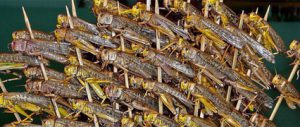Genetically engineered crops dominate cotton, soybean and corn farming in the US, accounting for more than 85% of the total acreage of all three.
The vast majority of these GM crops are herbicide-resistant, bred to survive powerful pesticides that are used to kill invading weeds and help prevent crop loss.
In theory, this helps reduce pesticide use, saving farmers money and reducing the negative environmental impact of the excessive use of chemicals, namely loss of wildlife.
Both supporters and opponents of GM crops acknowledge that the introduction of GM crops in the US in the 1990s — in particular the popular glyphosate-resistant crops developed by Monsanto and branded as Roundup-ready — led to a fall in pesticide use.
However, the increasingly widespread use of GM crops has, according to a recent study by Charles Benbrook, of Washington State University, coincided with a rise in herbicide-resistant weeds and pesticide used to control them.
Biotech companies admit that herbicide use has started to increase over the past five years, however, they refuse to point the blame at GM crops.
"Nobody disputes that in the last five years the trend on herbicide use in the US has increased and that one of the reasons for that is farmers have a problem with weeds resistant to glyphosate," says Graham Brookes of PGEconomics, a pro-GM consultancy. "But it is not only an issue related to GM crops. There are other non-GM herbicides that have got just as much, if not more, of a resistance problem."
The rise of the "superweeds"
While the media debate has tended to focus on the safety of GM crops and concerns about large biotech companies like Monsanto controlling the seed market and in turn, farmers, the problem of weed resistance in relation to GM crops, so-called "superweeds", has slipped under the radar.
Recent estimates from the International survey of herb-resistant weeds suggest 16 million acres (65,000 square kilometres) of cropland in the US is infested by glyphosate-resistant weeds. Benbrook, who also works for the Organic Centre in the US, argues the figure is more likely to be 60 million acres (243,000 square kilometres).
He predicts two-thirds of US cropland will be infested with weeds resistant to glyphosate within two to three years and says GM companies should more openly acknowledge the downsides of the mass switch to GM seeds reliant on glyphosate-based pesticides in the US.
Biotech companies themselves disagree, saying weed resistance has been "overplayed" as a problem.
Brookes estimates just 5-10% of the crop area in the US has a weed resistance problem, well short of Benbrook’s future prediction. "If it was a bigger problem for farmers we would be seeing them switching away from these crops," adds Brookes. He believes farmers should take the blame for the problem for overusing pesticides and not properly managing their farmland and that farmers should start to consider growing non-GM crops in some years to help stem the resistance problem.
See also: Beware the GM giants
For agriculture globally, the suggestion that GM crops are actually causing problems for farmers and forcing them to use more pesticides is a strong argument against using the technology.
"The creation of GM crops totally changed what weeds were subjected to…changed the weed resistance problem from an easily managed problem to a global crisis for farmers," says Benbrook.
"In the history of agriculture, there has never been an instance where resistance to a herbicide has spread so far and wide, and so fast, and imposed such profound economic and environmental consequences on farmers and rural communities," says Benbrook.
An "arms race" against nature
The biotech lobby group in the US, the Biotechnology Industry Organization, says in a statement that they "stand behind biotechnology’s environmental benefits and its role in feeding a growing world".
However, at the same time, biotech companies themselves are developing more powerful chemicals to tackle weeds resistant to existing pesticides. Dow Agrosciences is set to introduce a new GM crop based on the controversial Vietnam war weapon Agent Orange.
Dow says the pesticide is essential for maintaining food production: "Farm herbicide use has been steadily increasing for a number of years, and that increase is going to get worse without new agricultural technology to combat glyphosate-resistant weeds."
The scientific journal Nature was among those sceptical of the long-term success of an escalating "arms race" of more and more powerful chemicals.
"The [weed resistance] problem has escalated since the widespread introduction of Monsanto’s Roundup Ready and similar crops over the past decade allowed farmers to apply glyphosate more liberally," an article in the journal in May 2012 states. "The conventional approach is to switch to a different herbicide and engineer crops to withstand it. A number of analysts feel that such an approach is short sighted and doomed to fail," agronomist Matt Liebman of Iowa State University in Ames is reported as saying.
The solution for Benbrook and others is not more chemicals and GM crops but a switch away from monoculture and the reliance on GM.
He says Monsanto’s Roundup-Ready crops have encouraged "excessive reliance" on one weed management tool — glyphosate herbicide — and that is "bad" weed management. Also negative, at least in the eyes of some, is that the technology has helped move along the trend toward larger farms and fewer man-hours per bushel harvested. It promotes specialisation, and undercuts more diverse cropping patterns.
"Simple, farmers need to diversify their weed management tools and tactics. There are two ways to reduce resistant weeds and pests. One of those tactics is to use crop rotation, plant cover crops and use different field techniques to break the cycle of plants and insects. Another step, often overlooked, is to diversify the herbicides sprayed on any given field.
"Instead of just using a glyphosate year after year, farmers should mix up their choice of herbicides so the weed populations are confronted with herbicides that use different modes of action. If producers of corn and soybeans would only apply glyphosate once every three years, there likely would not be a problem," says Benbrook.



